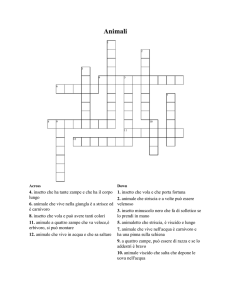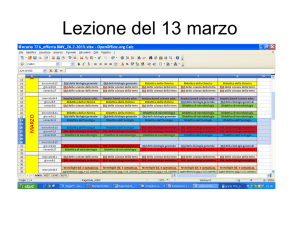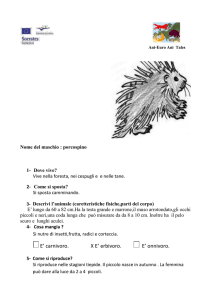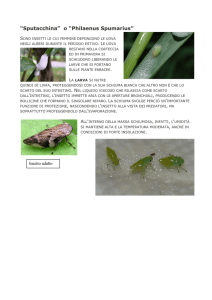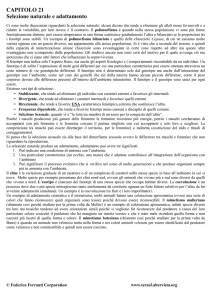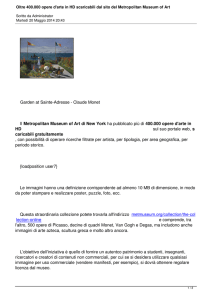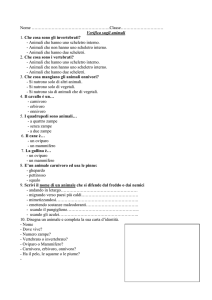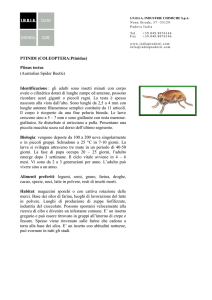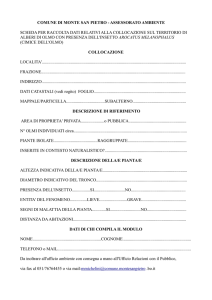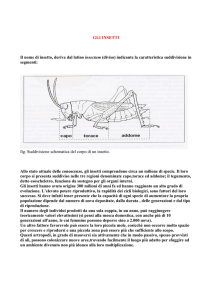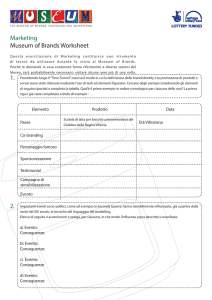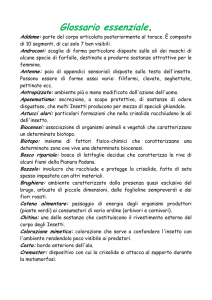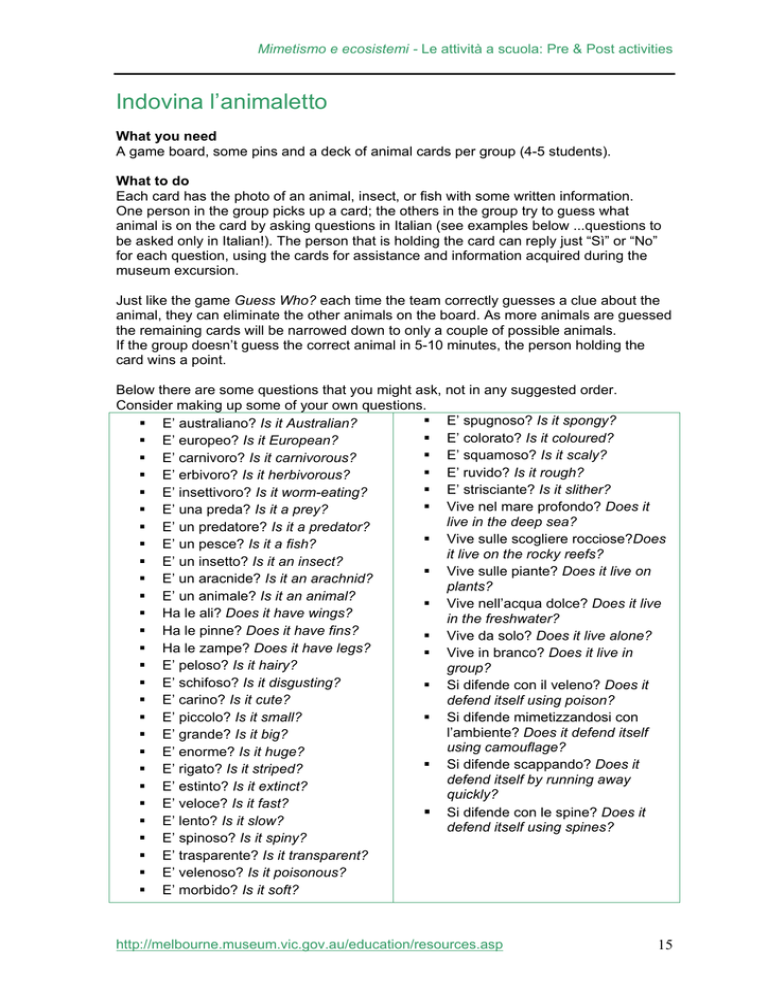
Mimetismo e ecosistemi - Le attività a scuola: Pre & Post activities
Indovina l’animaletto
What you need
A game board, some pins and a deck of animal cards per group (4-5 students).
What to do
Each card has the photo of an animal, insect, or fish with some written information.
One person in the group picks up a card; the others in the group try to guess what
animal is on the card by asking questions in Italian (see examples below ...questions to
be asked only in Italian!). The person that is holding the card can reply just “Sì” or “No”
for each question, using the cards for assistance and information acquired during the
museum excursion.
Just like the game Guess Who? each time the team correctly guesses a clue about the
animal, they can eliminate the other animals on the board. As more animals are guessed
the remaining cards will be narrowed down to only a couple of possible animals.
If the group doesn’t guess the correct animal in 5-10 minutes, the person holding the
card wins a point.
Below there are some questions that you might ask, not in any suggested order.
Consider making up some of your own questions.
E’ spugnoso? Is it spongy?
E’ australiano? Is it Australian?
E’ colorato? Is it coloured?
E’ europeo? Is it European?
E’ squamoso? Is it scaly?
E’ carnivoro? Is it carnivorous?
E’ ruvido? Is it rough?
E’ erbivoro? Is it herbivorous?
E’ strisciante? Is it slither?
E’ insettivoro? Is it worm-eating?
Vive nel mare profondo? Does it
E’ una preda? Is it a prey?
live in the deep sea?
E’ un predatore? Is it a predator?
Vive sulle scogliere rocciose?Does
E’ un pesce? Is it a fish?
it live on the rocky reefs?
E’ un insetto? Is it an insect?
Vive sulle piante? Does it live on
E’ un aracnide? Is it an arachnid?
plants?
E’ un animale? Is it an animal?
Vive nell’acqua dolce? Does it live
Ha le ali? Does it have wings?
in the freshwater?
Ha le pinne? Does it have fins?
Vive da solo? Does it live alone?
Ha le zampe? Does it have legs?
Vive in branco? Does it live in
E’ peloso? Is it hairy?
group?
E’ schifoso? Is it disgusting?
Si difende con il veleno? Does it
E’ carino? Is it cute?
defend itself using poison?
E’ piccolo? Is it small?
Si difende mimetizzandosi con
l’ambiente? Does it defend itself
E’ grande? Is it big?
using camouflage?
E’ enorme? Is it huge?
Si difende scappando? Does it
E’ rigato? Is it striped?
defend itself by running away
E’ estinto? Is it extinct?
quickly?
E’ veloce? Is it fast?
Si difende con le spine? Does it
E’ lento? Is it slow?
defend itself using spines?
E’ spinoso? Is it spiny?
E’ trasparente? Is it transparent?
E’ velenoso? Is it poisonous?
E’ morbido? Is it soft?
http://melbourne.museum.vic.gov.au/education/resources.asp
15
Mimetismo e ecosistemi - Le attività a scuola: Pre & Post activities
il gamberetto
la stella marina
il coniglio
Mangia Plankton, vive in mare
ed è una preda per i pesci:
per difendersi scappa
a tutta velocità.
Vive nel mare ed è carnivora.
Mangia molluschi e corallo, ma è
anche preda di altri pesci e delle
tartarughe. Si mimetizza con
l’ambiente.
E’ un animaletto Europeo. E’
erbivoro ed è una preda per gli
altri animali; se viene attaccato
scappa velocemente.
la vespa
il granchio Decorator
la volpe
E’ un insetto europeo, è erbivoro.
Mangia il polline dei fiori.
Si difende con il pungiglione,
una grande spina.
Vive in mare tra le alghe.
Si difende mimetizzandosi
con l’ambiente. E’ erbivoro:
mangia soprattutto alghe.
E’ un animale Europeo. E’ un
predatore ed è predatore ed è
carnivoro. Se viene cacciato
scappa velocemente.
l’insetto stecco
la lumaca
la formica Green Tree
E’ un insetto, è erbivoro ed è
preda di altri insetti e animali.
Per difendersi si mimetizza con
l’ambiente.
Non è
australiana, è
erbivora.
E’ australiana, è insettivora ed è
un predatore: attacca i suoi
nemici e li uccide con il veleno,
spruzza acido dall’addome.
http://melbourne.museum.vic.gov.au/education/resources.asp
16
Mimetismo e ecosistemi - Le attività a scuola: Pre & Post activities
il serpente corallo
E’ un animale australiano, è
carnivoro e mangia lucertole,
anfibi e altri piccoli animali. E’
velenoso.
il ragno
Redback
E’ un insetto australiano,
insettivoro ed è molto
velenoso.
Thylacine
Era un animale australiano, ma
adesso è estinto. Era un
predatore ed era carnivoro.
l’ornitorinco
lo squalo
E’ un insetto australiano, vive
nell’acqua dolce ed è un
predatore: caccia altri piccoli
insetti e piccoli pesci.
E’ un animale australiano.
E’ carnivoro: mangia insetti,
piccoli pesci e rane. Vive
nell’acqua dolce ed è preda
di animali più grandi.
E’ carnivoro ed è
un grande predatore.
Vive in mare aperto.
la spugna
il riccio
il polpo
Vive in mare sui fondali
sabbiosi tra altre spugne.
Si difende con il veleno.
Vive nel mare sulle scogliere
rocciose. Si difende dagli altri
animali usando le spine.
Vive in mare aperto, è
carnivoro ed è un predatore. Si
difende con il predatore.
Si veleno.
lo scarabeo
Green Diving Beetle
http://melbourne.museum.vic.gov.au/education/resources.asp
17
Mimetismo e ecosistemi - Le attività a scuola: Pre & Post activities
la medusa
il mantide religiosa
la tarantola
Vive in mare aperto, mangia
piccoli pesci e
Zooplankton, è carnivora.
Si mimetizza con l’ambiente
per difendersi.
E’ un insetto predatore: è
insettivoro.
E’ un ragno che viene
dall’Africa e dal Sud America.
E’ un predatore e uccide i
nemici con il veleno.
il canguro
l’echidna
la lucertola
E’ un animale australiano. E’
erbivoro; se viene attaccato
scappa velocemente.
E’ un animale australiano; è
insettivoro ed è una preda
degli animali più grossi, Si
difende con le spine.
E’ australiana ma ci sono
diverse famiglie di lucertole
nel mondo.
E’ insettivora.
http://melbourne.museum.vic.gov.au/education/resources.asp
18
Mimetismo e ecosistemi - Le attività a scuola: Pre & Post activities
CONIGLIO
ORNITORINCO
RAGNO REDBACK
FORMICA
THYLACINE
MEDUSA
MANITIDE RELIGIOSA
VOLPE
CANGURO
SPUGNA
INSETTO STECCO
RICCIO
GREEN TREE
INDOVINA L’ANIMALETTO…
POLPO
GAMBERETTO
LUMACA
SQUALO
SERPENTE CORALLO
SCARABEO
GREEN DIVING
ECHIDNA
LUCERTOLA
STELLA MARINA
http://melbourne.museum.vic.gov.au/education/resources.asp
VESPA
GRANCHIO DECORATOR
TARANTOLA
19
Mimetismo e ecosistemi - Le attività a scuola: Pre & Post activities
Attivita’ di ascolto: Livello 1
Listen to the descriptions of each organism and circle the words that you hear in each
description.
SPUGNA
FOCA
VELENO
STELLA MARINA
MIMETISMO
FLORA SPUGNOSA
FONDALE SABBIOSO
COLORATA
TRASPARENTE
INSETTO
ANIMALE
APE
MANTIDE
TANTE SPINE
MIMETISMO
INSETTO
UN PUNGLIGLIONE
VELENO
COLORATA
ANIMALE
CANGURO ROSSO
ERBIVORO
ROSSO
VERDE
INNOCUO
TRASPARENTE
KOALA
VICTORIA
ORSO
DESERTO
INSETTIVORO
GRIGIO
LUCERTOLA
AUSTRALIA
VESPA
LENTO
SERPENTE
ROSSO
ERBIVORO
NERO
VELOCE
EUROPA
BIANCO
CARNIVORO
VELENOSO
http://melbourne.museum.vic.gov.au/education/resources.asp
20
Mimetismo e ecosistemi - Le attività a scuola: Pre & Post activities
Attivita’ di ascolto: Livello 1 (il testo)
1)
Salve, sono la spugna. Vivo nel mare, nella flora spugnosa. Sono bella e colorata,
ma a volte uso il veleno.
2)
Salve, sono un insetto: una vespa. Ho il pungiglione: una grande spina. Uso il veleno
per difendermi. Sono colorata: I miei colori sono giallo e nero.
3)
Salve, sono un famoso animale australiano: il canguro rosso! Vivo nel deserto e
sono erbivoro. Sono molto veloce e ho un bel colore rosso.
4)
Ciao, sono il serpente corallo. Vivo in Australia e sono molto velenoso. Sono rosso e
bianco. Sono carnivoro, mangio piccolo animali.
http://melbourne.museum.vic.gov.au/education/resources.asp
21
Mimetismo e ecosistemi - Le attività a scuola: Pre & Post activities
Attivita’ di ascolto: Livello 2
Listen to the descriptions and match them with the correct species. Place the corresponding
number in the box.
http://melbourne.museum.vic.gov.au/education/resources.asp
22
Mimetismo e ecosistemi - Le attività a scuola: Pre & Post activities
Attività di ascolto: Livello 2 (il testo)
Il ragno redback
Sono un insetto e sono australiano. Sono piccolo, lucido e colorato: i miei colori sono il
rosso e il nero. Vivo nella ragnatela che costruisco spesso nei cumuli dei giardini. Sono un
predatore e sono insettivoro; se mi capita mangio anche lucertole e i piccoli animali che
restano intrappolati nella ragnatela.
Sono molto cattivo: sono velenoso, anche per l’uomo.
Il coniglio
Sono un animale e non sono australiano. Sono carino, morbido e peloso: alcuni mi tengono
anche come animale domestico.
Ho lunghe orecchie e occhi grandi; sono una preda e devo scappare dagli animali più
grossi.
Sono erbivoro e mi piacciono le carote.
Il squalo
Sono un pesce e vivo nel mare profondo. Sono molto grande e la mia pelle è lucida e grigia.
Sono molto cattivo e sono carnivoro: con i miei denti aguzzi mangio gli altri pesci e se mi
capita assaggio anche l’uomo.
L’ insetto stecco
Sono un insetto e vivo sulle piante. Sono erbivoro e mangio le foglie.
Non sono cattivo: sono una preda e per nascondermi mi mimetizzo con le foglie: infatti sono
piccolo e verde.
Thylacine
Ero un animale australiano ma adesso sono estinto.
http://melbourne.museum.vic.gov.au/education/resources.asp
23
Mimetismo e ecosistemi - Le attività a scuola: Pre & Post activities
Identikit di un animaletto
Choose an animal that you would expect to see at the museum and fill in the Identikit about
the animal. Look at: http://melbourne.museum.vic.gov.au/exhibitions/index.asp
NOME:
FAMIGLIA
Place a photo of
your animal here.
(insetto, pesce, mammifero):
CARATTERISTICHE( 4 aggettivi per descrivere l’animale)
HABITAT
(dove’ vive?):
Che cosa mangia?
E’ erbivoro e mangia………………………………………………………………
E’ carnivoro e mangia……………………………………………………………
E’ insettivoro e mangia…………………………………………………………
Che tipo di animale è?
E’ una preda
E’ un predatore
Come si difende?
Si difende con…………………………………………………………………………
http://melbourne.museum.vic.gov.au/education/resources.asp
24
Mimetismo e ecosistemi - Le attività a scuola: Pre & Post activities
Writing tasks - ICT activities
Photographs of the exhibitions within the Science & Life Gallery have been provided to give
students the opportunity to produce a publication or slideshow presentation back at school
of their visit to Melbourne Museum
The students could work individually or in small groups on the computer. The task could be
presented as a PMI thinking tool (Plus Minus Interesting) available under 'Graphic
organisers', on the web page http://vels.vcaa.vic.edu.au/support/teaching.html#graphic,
where students write captions for photos of their choice according to the PMI model.
Once collated, the images and captions can be made into a newsletter or slideshow ready to
be viewed by the class. This project could then be placed on the school's website to be
viewed by other members of the school community.
Puffer fish
Whale and squid meet
Harlequin Beetle
Centipede
Red back spider
Desert Scorpion
Sperm whale at Melbourne Museum
Tarantula
http://melbourne.museum.vic.gov.au/education/resources.asp
Green Carabid Beetle
25
Mimetismo e ecosistemi - Le attività a scuola: Pre & Post activities
Mountain Ash
Ferns
Alpine Tree Frog
Manna Gum
Mallee fowl
http://melbourne.museum.vic.gov.au/education/resources.asp
26

